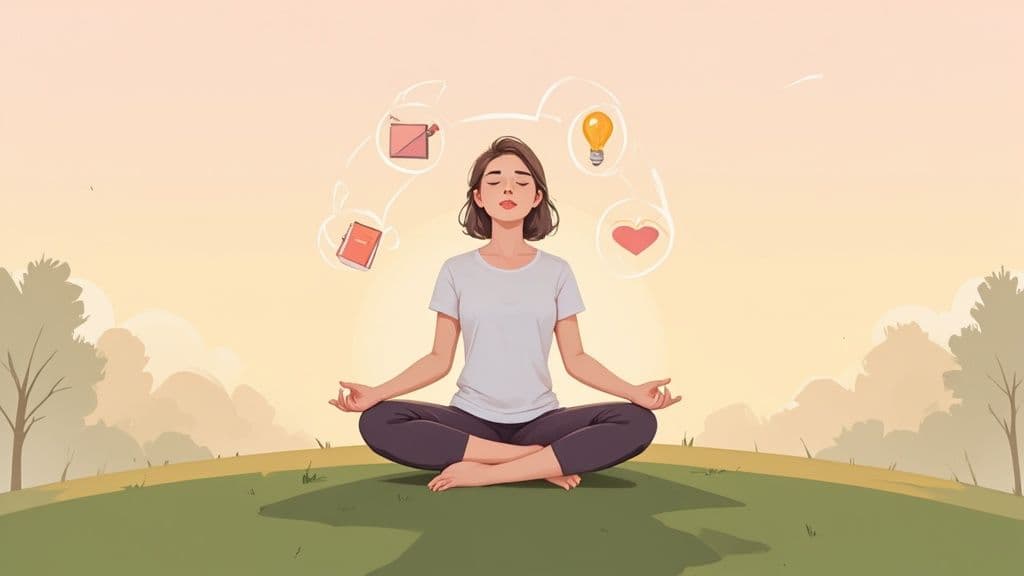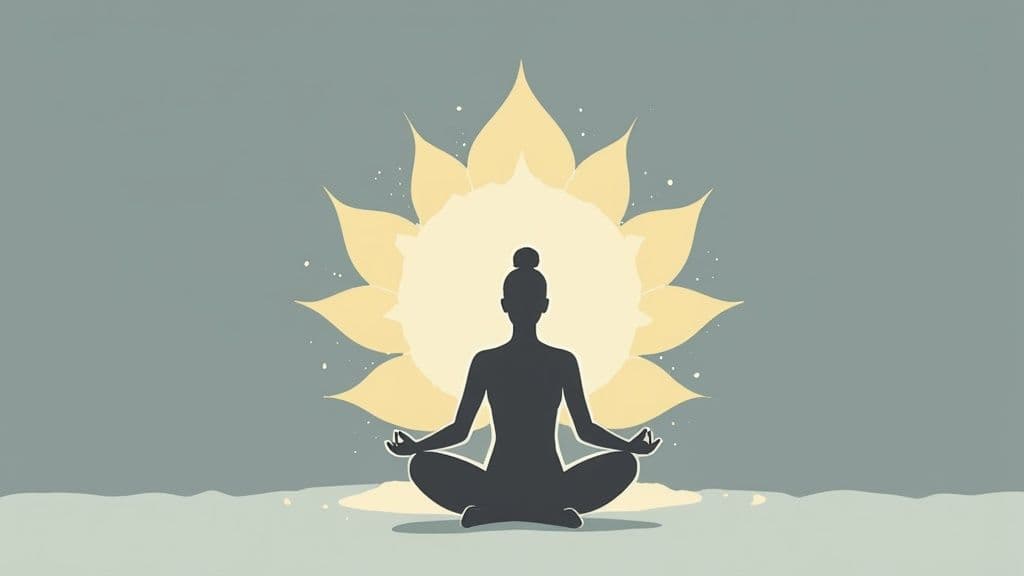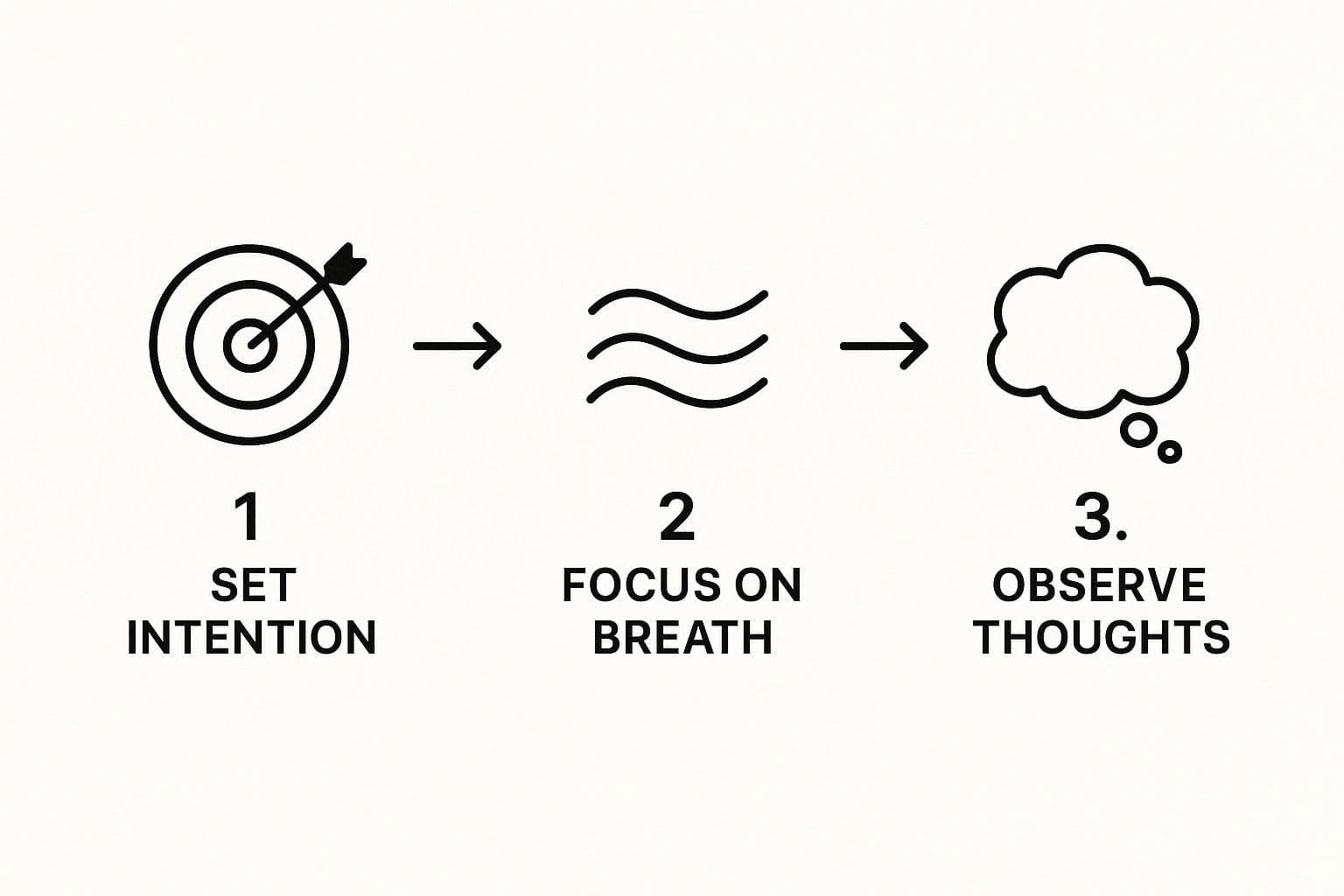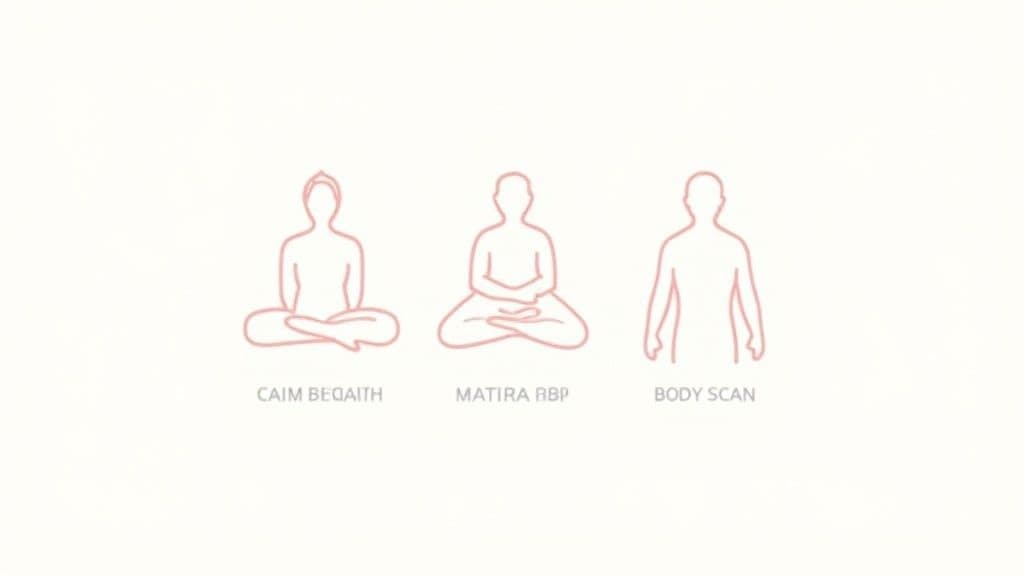Begin your inward journey with a clear, practical guide to meditation for self-discovery. Learn simple techniques, journaling prompts, and a framework to uncover your authentic self and bring insights into daily life.
August 20, 2025 (4mo ago) — last updated November 16, 2025 (1mo ago)
Meditation for Self-Discovery: Practical Steps
Practical meditation techniques, journaling prompts, and a simple framework to uncover your authentic self and live with more intention.
← Back to blog
Meditation for Self-Discovery: Practical Guide
Begin your journey inward with this practical guide to meditation for self-discovery. Learn approachable techniques, journaling prompts, and a clear framework to uncover your authentic self and bring those insights into everyday life.
Why Meditation Is Your Compass for Self-Discovery

Our world is noisy. Between work, social pings, and a never-ending to-do list, hearing your inner voice can feel impossible. Meditation isn’t a mystical ritual; it’s a practical way to tune out the static so you can notice thoughts and patterns.
The goal isn’t an empty mind. Practice becoming a curious, nonjudgmental observer of your thinking. When you sit in stillness you begin to notice mental loops, knee-jerk emotional reactions, and the stories you tell yourself on autopilot. That noticing is the first real step toward genuine self-awareness.
Creating Space for Inner Clarity
Think of the mind as a lake. When the wind constantly stirs the surface with worries and distractions, the water gets choppy and murky and you can’t see what’s below.
Meditation lets the wind die down. As the water settles, sediment drifts to the bottom and the lake becomes clear. Suddenly you can see the rocks, plants, and hidden life below. A quieted mind works the same way, allowing you to see your inner landscape with startling precision.
“The goal of meditation is not to control your thoughts, it’s to stop letting them control you.”
Meditation has become mainstream worldwide. An estimated 200 to 500 million people now meditate globally1, and the number of adults practicing in the U.S. has increased significantly in recent years2. These trends reflect a cultural shift toward looking inward for answers.
Uncovering Your Authentic Self
Quiet observation helps you untangle who you really are from who you’ve been told you should be. Through regular practice you’ll start to notice:
- Your core beliefs, some of which may be outdated and holding you back
- Your emotional triggers, and why certain things set you off
- Your true desires, what you genuinely want apart from external expectations
Using meditation for self-discovery builds a better relationship with yourself. The insights you gain become a reliable inner compass, guiding decisions and helping you build a life that feels aligned with who you are. For practical tools, the Life Purpose App explores how inner insights can connect to long-term purpose and choices. You can learn more at /life-purpose-app.
Foundational Meditation Techniques for Your Journey
You don’t need a retreat or years of training to begin. Simple methods can ground you and open space to listen inward. Choose approaches that feel right and build a steady practice.
The meditation market is growing quickly, reflecting higher public interest and adoption3.
Core Techniques for Self-Discovery
| Technique | Primary Focus | How it fuels self-discovery |
|---|---|---|
| Mindful Breath Awareness | Present-moment noticing | Strengthens attention, fosters mental clarity |
| Body Scan Meditation | Physical sensation mapping | Reveals tension patterns, connects body and mind |
| Loving‑Kindness (Metta) | Cultivating compassion | Softens self-criticism, builds a kinder inner dialogue |
Pick a starting point or weave these practices together as your practice grows. For basics on posture and creating a routine, see /meditation-basics.
Ground Yourself with Mindful Breath Awareness
Breath work is the doorway into meditation. Try this simple approach:
- Notice each inhalation and exhalation
- Feel air moving through your nostrils and belly
- Gently return your focus when the mind wanders
This is observational—watching the breath rather than forcing it. Over time, that observation trains your mind to step back from swirling thoughts.

Connect with a Body Scan Meditation
Our bodies often hold stories we haven’t heard yet. A body scan takes you from toes to crown, pausing to notice warmth, tightness, or ease in each area.
“By paying attention to the body, we learn to inhabit our lives more fully. Physical sensations become maps to unseen emotions.”
This practice can transform stress into insight, helping you locate where emotions surface so you can meet them with curiosity.
Cultivate Self-Compassion with Loving‑Kindness
Unearthing buried hurts can feel tender. Loving‑kindness meditation offers a soft landing. While seated comfortably, silently repeat phrases like:
- May I be happy
- May I be healthy and strong
- May I live with ease
Then extend those wishes to a friend, a neutral person, and even someone who challenges you. Over time, this practice develops a kinder inner voice that’s essential for self-discovery.
Making Sense of Your Meditation with a Journal

If meditation opens a door to your inner world, journaling draws a map of what’s inside. Those quiet insights can disappear as quickly as they arrive; writing them down bridges silent awareness and practical wisdom.
Journaling is an active conversation with yourself. Turning abstract feelings into words helps you spot patterns, get to the root of triggers, and identify what truly matters. This is where meditation for self-discovery turns into ongoing personal growth.
From Stillness to Clarity
The few minutes after meditation are particularly insightful. Your mind is quiet, open, and receptive, an ideal time to journal. Instead of jumping back into the chaos, take five minutes with a notebook.
Research supports that mindfulness practice improves emotional regulation and self-care, which is crucial for growth and well-being4.
“When you put inner experience into words, you give it shape and meaning. An unnamed anxiety becomes a recognized fear. A vague idea crystallizes into a clear intention.”
This is how you move from passive observation to active participation in your own growth.
Journaling Prompts to Get Started
You don’t need to write a novel. A few focused sentences can be powerful. After your next meditation, try one of these prompts:
- What one feeling or physical sensation kept grabbing my attention? What could be behind it?
- If I could let go of one fear or worry I noticed, how would my day change?
- What was the toughest part of my sit today, and what does that tell me about my current state of mind?
- Did any surprising memories or ideas pop up? What message might they hold for me?
- Based on how I feel right now, what’s one small, kind thing I can do for myself today?
Pick one that speaks to you and let the words flow without judgment.
How to Make Journaling Stick
Like meditation, the magic happens with consistency. Find a routine that feels easy:
- Keep it simple. A basic notebook and a pen are enough
- Set a timer. Start with three to five minutes
- Look back. Once a month, read past entries to connect the dots and notice progress
For guided journaling prompts and worksheets, see /journaling-guides.
Using Numerology as a Framework for Self-Discovery
Meditation opens a direct line to your inner world; sometimes you need a framework to make sense of what you find. Dan Millman’s book, The Life You Were Born to Live, presents a numerology-based system that offers one such framework.
This approach isn’t fortune-telling. It’s a way to map core energies and themes shaped by your birthdate. The Life Purpose App brings that system into an accessible format and can help translate meditation insights into actionable meaning.
Finding Your Life Number
Your life number points to a primary energy to master in this lifetime. The basic calculation adds the digits of your birthdate until you reach a single number. Each number suggests themes, strengths, and lessons that can cast new light on patterns you observe in meditation.
This framework gives context to inner discoveries, helping you see that patterns aren’t random but part of a meaningful design for your life.
A Deeper Dive with the Life Purpose App
Knowing your life number opens a new level of self-awareness. It can clarify why you’re drawn to certain careers, why relationship dynamics repeat, or why specific obstacles recur. The book and the Life Purpose App offer:
- Core gifts and challenges tied to your number
- Key life themes like money, health, and relationships
- Nine-year cycles that describe natural rhythms and focus
This system won’t give all the answers, but it helps you ask better questions and align choices with your deeper purpose.
Weaving Your Inner Discoveries into Daily Life

Insight without action is just an interesting thought. The real benefit of meditation for self-discovery is carrying clarity off the cushion into everyday choices, conversations, and routines. This doesn’t require upending your life; small, intentional shifts add up.
Start Making Decisions Mindfully
Pause before decisions, from lunch choices to career moves. That brief pause creates space between a trigger and your reaction, giving your inner wisdom a chance to speak.
For example, if offered a promotion that looks great on paper but feels suffocating to your creativity, meditation helps you notice that tension and make a decision aligned with your emerging priorities.
Ask yourself:
- Does this align with the purpose I’m discovering?
- What’s my gut reaction, tense or expansive?
- Is this a step toward who I want to become or away from them?
These simple check-ins connect daily actions to inner truth.
Communicate Your Truth with Kindness
Self-discovery often uncovers needs and boundaries you didn’t know you had. Sharing them can feel vulnerable. The secret is honesty paired with kindness.
If you’ve learned you need more quiet time, try: “I really appreciate you thinking of me. I’ve realized I need more downtime to feel my best, so I’ll sit this one out. Let’s plan something soon.”
Speaking your truth from self-respect, rather than frustration, makes it easier for others to hear and supports healthier relationships.
Living an Aligned Life, One Choice at a Time
Your meditation insights are the map; you steer the car. Each mindful choice is a correct turn. Over time the practice becomes natural, and living an authentic life shifts from goal to ordinary behavior.
Top Questions About Meditation and Self-Discovery
Am I doing this right?
Yes. If you’re showing up and practicing, you’re doing it right. There’s no perfect way to meditate; there’s only your honest experience.
What if my mind is too busy to meditate?
A busy mind is normal. The practice is to change your relationship with thoughts, not stop them. Notice them like cars on a highway and gently return to your anchor when you drift.
How will I know I’m making progress?
Progress often shows up off the cushion: a split-second pause before reacting, less reactivity to small stresses, or catching an old negative thought and choosing differently. Frameworks like Dan Millman’s system can help you see patterns and measure growth.
Quick Q&A — Common Questions, Short Answers
How long should I meditate to notice change?
Start small: three to ten minutes daily. Consistency matters more than length. Gradually increase as it feels sustainable.
What should I journal after a sit?
Write one sentence about the strongest feeling or image you noticed, then one small action you can take based on that insight.
Can numerology really help my growth?
Numerology is a reflective framework. It won’t give all the answers, but it can highlight recurring themes and prompt useful questions.
Concise Q&A Section 1 — Practice Basics
Q: How do I start if I’m new?
A: Pick a short practice—mindful breath or a three-minute body scan—and do it daily. Build habit over intensity.
Q: Where should I sit?
A: Find a quiet, comfortable spot. Posture matters less than regularity.
Q: What if I fall asleep?
A: Try a slightly more upright seat or shorter sits earlier in the day.
Concise Q&A Section 2 — Journaling & Integration
Q: When is the best time to journal?
A: Right after meditation, when insights feel fresh.
Q: How much should I write?
A: Three to five focused minutes or one clear sentence plus one action step.
Q: How do I track progress?
A: Review entries monthly to spot patterns and small shifts.
Concise Q&A Section 3 — Frameworks and Meaning
Q: Should I use numerology to interpret insights?
A: Use it as one lens among many; it can suggest themes and questions but not fixed answers.
Q: How do I apply insights to decisions?
A: Pause, check alignment with your core values, and choose the option that feels expansive rather than constricting.
Q: When should I seek outside help?
A: If meditation uncovers trauma or intense emotions that feel overwhelming, consider a therapist or trained facilitator.
Discover Your Life Purpose Today!
Unlock your true potential and find your life’s purpose.
